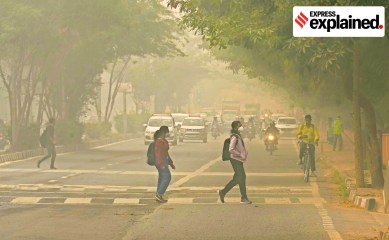Farm fires and weather behind choke; respite likely in 4 days
The intensification in agricultural burning in Punjab, an annual practice now, usually lasts for about two weeks. This year, the spike was seen from October 31.

With incidents of agricultural waste burning in Punjab showing a sharp rise, the smog and haze situation in Delhi is likely to remain grim for at least four days before an expected change in meteorological conditions hopefully results in an improvement.
The intensification in agricultural burning in Punjab, an annual practice now, usually lasts for about two weeks. This year, the spike was seen from October 31. With 35 per cent of the area under paddy cultivation in Punjab, amounting to about 10 lakh hectares of land, still remaining to be harvested, the burning events are likely to continue for some time.
The only hope for an improvement in the air quality situation is a disruption in the prevailing meteorological conditions, which, as per their normal behaviour during this time of the year, actually worsens the situation by trapping the polluting particles in the lower layers of the atmosphere. A western disturbance event, expected around November 7, could change that.
“There is a subsidence in the air right now. During the winters, the atmospheric circulation over this region is usually anti-cyclonic in nature. This makes the air move downwards. In a cyclonic circulation, as during the monsoon season, the air tends to move up. But because the air tends to move downwards right now, it prevents the pollutant particles from escaping vertically, and keeps them near the surface. It is not that the weather is causing this pollution, but it is not doing anything right now to help matters,” said Mrutyunjay Mohapatra, Director General of India Meteorological Department.
The main culprit, clearly, is the spike in agriculture burning incidents in Punjab. Nearly 40 per cent of all burning events in the state, 5,140 out of a total of nearly 12,800 documented events since September 15, have happened in the first three days of this month.
“There are a few prime suspects causing this situation. Emissions in Punjab getting pushed into Delhi, along with meteorological factors may be playing a role. Winds appear to be sweeping through Pakistan and Punjab, crossing Haryana, and reaching Delhi. These winds have been pushing pollutants in from Punjab and Haryana into Delhi. Over the past three to four days, there has been an intensification of fire counts,” said Sachchida Nand Tripathi, Professor at IIT Kanpur and Steering Committee member, National Clean Air Programme.
“The boundary layer (the layer of the troposphere in contact with the surface of the earth) has been lower. The boundary layer generally becomes shallower November onwards, suppressing the atmospheric ability to push pollutants upwards. It’s like a ceiling. If the rooftop is brought lower, you will feel more suffocated. A deeper boundary layer will allow pollutants to move upwards, and where we are, our exposure will be lesser. As temperature falls further, the boundary layer falls further. The boundary layer was around 400 m on October 26, and dropped further to around 200 m this week, which is very shallow,” he said.
“The wind has changed direction from southeast to northwest. This is very adverse meteorology. The ventilation, which is the dispersion capacity of the atmosphere, and depends on boundary layer height and vertical wind velocity, is poor,” Tripathi added.
Respite could come from better wind speed or rainfall, but both remain elusive. There is no rainfall on the IMD forecast for Delhi at least for the next six days. But the possibility of a western disturbance gives hope.
This western disturbance event is expected to bring light showers to Jammu and Kashmir and parts of Himachal Pradesh but not in Delhi. But it could still change the wind systems.
“When the western disturbance comes in, sometimes it disturbs the prevailing atmospheric conditions. The anti-cyclonic circulation can, even temporarily, change into a cyclonic circulation, the direction of the winds flowing in from Punjab can also change,” said Mohapatra. “All this can result in the dispersion of the pollutants, and could lead to relief. The best-case scenario would, of course, be rain. But rain is not expected over Delhi or the surrounding areas during this coming western disturbance event. But it does bring about other changes, we can hope for an improvement in the situation from November 8.”
The Air Quality Early Warning System for Delhi said the situation was expected to improve “marginally” on Saturday, but remain in the “severe category” till Monday at least. Even the outlook for the subsequent six days, reaching up to Diwali, was for air quality to remain in the “severe” to “very poor” category.
Gufran Beig, founder project director SAFAR, and chair professor, National Institute of Advanced Studies, no significant improvement could be expected till the fire counts in Punjab went down.
“A fire count of 100 or less may not have an impact, but a count over 500 will,” Beig said.
For the first three days of this month, the reported fire counts in Punjab averaged over 1,700 a day.